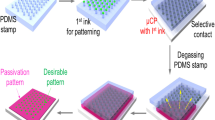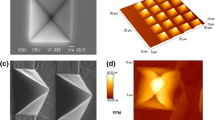Abstract.
Microcontact printing (µCP) has been used to introduce temporary hydrophobic barriers on carboxymethylated dextran (CMD) hydrogels on gold. Among the investigated types of inks, tetraoctadecylammonium bromide (TOAB), electrostatically bound to the CMD layer, provided the most well-defined features both with respect to pattern-definition and reversibility upon exposure to a regeneration solution. The printed patterns were characterized by atomic force microscopy (AFM), scanning electron microscopy (SEM), microscopic wetting and imaging null ellipsometry to explore the influence of concentration of ink solution and contact time on the appearance of the printed layer. AFM revealed that the printed TOAB molecules aggregated into clusters rather than into a homogeneous mono- or multilayer on the CMD hydrogel. It was also observed that printed areas of TOAB that are larger than 25 µm are inhomogeneous most likely because of an edge transfer lithography (ETL) mechanism. A protein model system based on Protein A-rabbit antimouse Fcγ was used to evaluate the potential of the patterned surface as a protein microarray chip by means of surface plasmon microscopy (SPM). Moreover, non-specific adsorption of several proteins onto TOAB barriers was also studied using surface plasmon resonance (SPR), and it is evident that undesired adsorption can be eliminated by removing barriers after ligand immobilization, but prior to analyte exposure, by treating the patterned surface with a simple salt regeneration solution.
Similar content being viewed by others
Author information
Authors and Affiliations
Corresponding author
Rights and permissions
About this article
Cite this article
Zhou, Y., Andersson, O., Lindberg, P. et al. Reversible Hydrophobic Barriers Introduced by Microcontact Printing: Application to Protein Microarrays. Microchim. Acta 146, 193–205 (2004). https://doi.org/10.1007/s00604-003-0174-2
Received:
Accepted:
Published:
Issue Date:
DOI: https://doi.org/10.1007/s00604-003-0174-2




